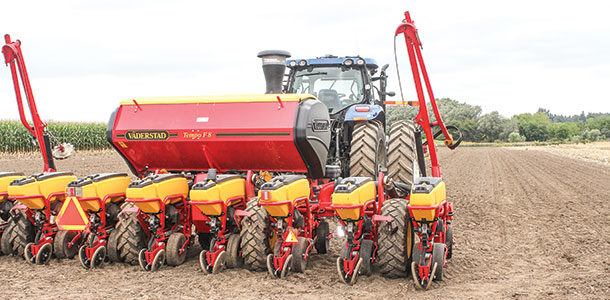Most people are familiar with the four rations on the farm – the one formulated by the nutritionist, the one mixed, the one delivered to the bunk and the one the cows ate. But did you also know that same type of variation lurks within your forages?
That’s right – the forages you rely on to be the backbone of your ration can be highly variable when fed to the cows. Everything from the hybrids selected, growing conditions, harvest timing and even storage can all affect how many nutrients the cows can utilize from forages.
Instead of reacting to problems that arise during feedout, learn how to plan your forage production in order to optimize cow performance. Use these steps to get started.
Know your land
Start by asking some questions. Identify soil type, potential for erosion, fertilization and the average rainfall in your area. Have you been in a drought pattern or receiving above-average rainfall?
What does the National Oceanic and Atmospheric Administration (NOAA) seasonal drought outlook monitor say for your area? If you irrigate, what is your water availability? What is the cropping history? All of these factors can be used to help decide what forages to plant for next year and on which field.
Understand forages feed differently
When looking at different forages to plant, there are trade-offs to be aware of, and those trade-offs need to be managed accordingly.
If water is a limiting factor, growing sorghum instead of corn silage can make sense. But remember, sorghum silage feeds a little differently than corn silage. It’s not a simple pound-for-pound substitution.
Sorghum silage has about 15 more percentage units of neutral detergent fiber (NDF) than corn silage. But it also has about 15 less units of starch and sugars. Inside the rumen, NDF digestibility is similar, but the amount of rumen-digestible starch and sugars from sorghum silage will be less than that from corn silage.
Alfalfa is another consideration for forages. As a general rule, alfalfa is high in protein and high in effective fiber.
Understanding the differences in how cows utilize these forages can help you create a plan to grow the best mix of forages for your cows.
Forages not only provide energy and needed nutrients to the diet, they also play an important role in stimulating rumination and salivary buffer production as well as providing proper rumen fill. This, in turn, can help you improve digestibility, feed efficiency and cow performance.
Look at other feedstuffs
Before you decide what forages to plant, evaluate the other feedstuffs available in your area to determine which ingredients best complement the forages you intend to grow. Keep in mind that forage, starch, protein and byproduct variation can account for up to 65 percent of all on-farm variation in fat-corrected milk production.
These sources of variation must be understood, measured and controlled in order for the cows to deliver consistent performance.
Having enough rumen degradable starch, rumen undegraded NDF (or rumen “fill”), metabolizable energy and metabolizable protein in the diet are critical.
Since sorghum silage has less rumen degradable starch than corn silage, you will need to add another ingredient such as ground corn to the ration. Depending on the price of corn, that could significantly alter your ration cost.
Once these factors have been considered, calculate your ration cost to see which options are the most cost-efficient.
Hybrid selection
Pick a few hybrids that are consistent performers and build your forage program around them.
Look first at hybrids adapted to growing conditions in your area. Consider their ratings for standability, disease resistance and drought tolerance.
Now narrow your list of hybrids using silage-specific traits such as silage yield, fiber digestibility and whole-plant digestibility as well as starch yield and starch digestibility.
When selecting alfalfa varieties be sure to consider winter hardiness, yield potential, forage quality and disease and pest resistance.
Manage harvest
The timing of harvest greatly affects how forages will feed out to the cows.
For example, waiting for greater ear fill before harvesting corn silage will result in higher starch content. However, the starch may also become less available in the rumen. Remember, the amount of rumen degradable starch in the ration affects cow productivity.
Rations with less-than-optimal amounts of available starch often result in less milk production but higher components. Too much available starch can depress the butterfat content of milk and dry matter intake.
Starch content and rumen degradable starch have an inverse relationship in corn silage at harvest. This not only can affect early feeding value but may influence kernel processing effectiveness. That makes selecting the proper harvest time imperative for the best feedout results.
A similar situation occurs with effective fiber in alfalfa. Waiting to harvest alfalfa in order to capture more tons per acre can result in decreased digestibility. So while you may harvest 10 percent more dry matter per acre, the digestibility may be lower.
If not accounted for in the ration, milk production may decrease. If digestibility is too low, forages may have to be replaced with purchased high-fiber byproducts to limit excessive rumen fill and maintain intake and cows’ productivity.
Monitor plant development throughout the growing cycle. That way you won’t miss the window to harvest forages at the optimal time.
Be proactive
It’s a balancing act to select forages that will deliver the right amount of starch, effective fiber and digestibility to the ration. In addition, the distribution of fiber digestibility and the distribution of starch digestibility among silage sources within a particular geography can vary from year to year. That makes testing before feeding critical.
Work with your agronomist and nutritionist to become more proactive about the forages you grow and feed. Doing so can help your cows deliver more consistent performance.













